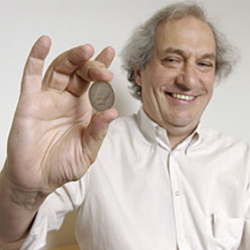University of Colorado
Forty-Fifth Annual DeLong Lecture Series
Department of Mathematics
Professor Persi Diaconis
Harnessing Chance
|
Date |
Time |
Room |
Title |
||
|
Monday, August 25, 2008 |
4:00-5:00 pm |
BESC 180 |
The Search for Randomness I will examine some of our most primitive images of random phenomena: flipping a coin, rolling dice and shuffling cards. In each case, analysis shows that, while things can be made approximately random, usually we are lazy and the results are quite non-random. Applications are given to computer simulations and statistical models more generally. |
||
|
Wednesday, August 27, 2008 |
4:00-5:00 pm |
KOBL 210 |
Harnessing Chance I will argue that Monte Carlo simulations are everywhere dense in applied mathematics. Further, designing, improving and analyzing simulation techniques leads to fascinating mathematics, from micro-local analysis to Hecke algebras. Following Wednesday's lecture, there will be a reception in honor of Professor Diaconis at the Koenig Alumni Center, 1202 University Avenue (the SE corner of Broadway and University). |
||
|
Thursday, August 28, 2008 |
10:00-11:00 am |
MATH 350 |
On adding a list of numbers The process of "carries" in ordinary addition has a surprisingly neat analysis. This has direct links to the mathematics of shuffling cards, symmetric function theory and sections of generating functions. |
||

Persi Diaconis |
||
Persi Diaconis is the Mary V. Sunseri Professor of Statistics and Mathematics at Stanford University and was elected into the National Academy of Science in 1995. He has done outstanding work in probability, statistics, and combinatorics, and he is particularly known for tackling mathematical problems involving randomness and randomization, such as coin flipping and shuffling playing cards. Professor Diaconis received a MacArthur Fellowship in 1979, and again in 1992 after the publication (with D. Bayer) of a paper entitled "Trailing the Dovetail Shuffle to Its Lair", a term coined by magician Charles Jordan in the early 1900s. This established rigorous results on how many times a deck of 52 playing cards must be riffle shuffled before it can be considered "random enough". He established that the deck gradually increases in randomness until seven shuffles, after which the thus-far experienced increase in randomness stops significantly increasing. At least seven shuffles, for reasons made precise in the paper, is what casinos should use. Among the highlights of his research is his work on the speed of convergence of Markov chains to equilibrium, and his contributions to Bayesian statistics. His pioneering applications of non-commutative Fourier analysis and techniques from algebraic structures have contributed greatly to our understanding both of random walks on finite structure models for group valued data, and of simulations of probabilities on combinatorial structures. As both a magician and a statistician, Professor Diaconis has debunked much research on extra sensory perception and the paranormal, and has exposed several psychics. |
DeLong Lecture Series | ||
This Lecture Series is funded by an endowment given by Professor Ira M. DeLong, who came to the University of Colorado in 1888 at the age of 33. Professor DeLong essentially became the mathematics department by teaching not only the college subjects but also the preparatory mathematics courses. Professor DeLong was a prominent citizen of the community of Boulder as well as president of the Mercantile Bank and Trust Company, organizer of the Colorado Education Association, and president of the charter convention that gave Boulder the city manager form of government in 1917. After his death in 1942, it was decided that the bequest he made to the mathematics department would accumulate interest until income became available to fund DeLong prizes for undergraduates and DeLong Lectureships to bring outstanding mathematicians to campus each year. |
||
|
|
CU Math Home